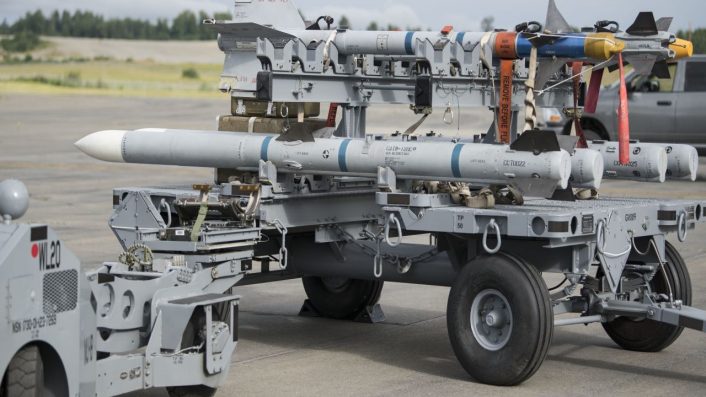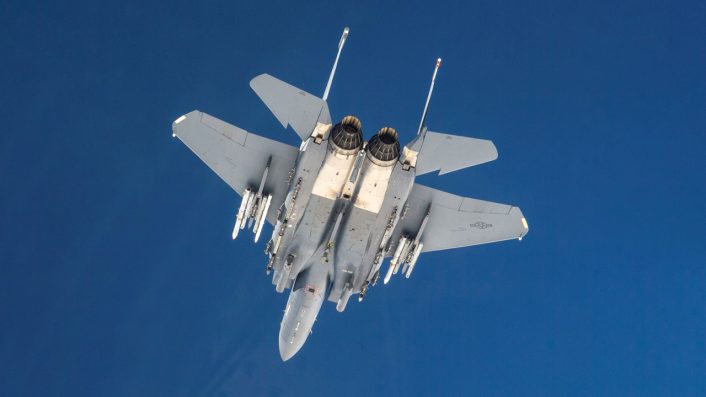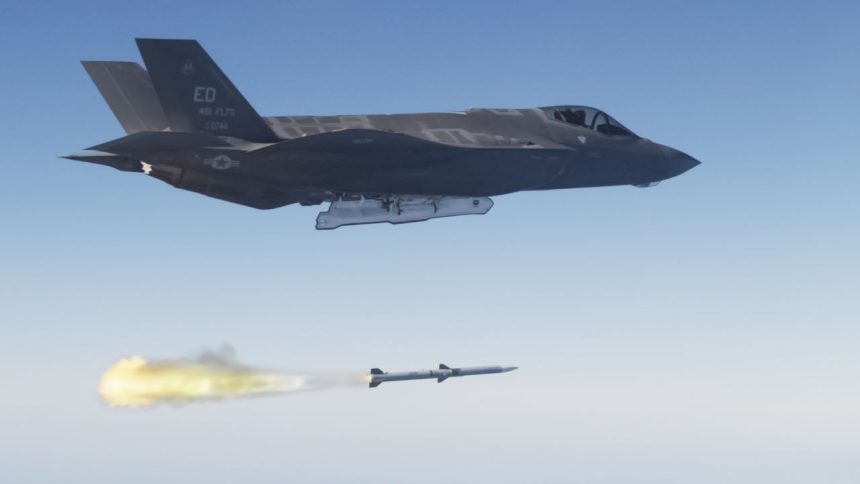Raytheon’s John Norman told journalists that the AMRAAM’s range is approaching that threshold capability that the Air Force would like to have with JATM when it’s fielded operationally.
Raytheon’s under-development AIM-120D3 AMRAAM (Advanced Medium Range Air-to-Air Missile) variant may become part of a high/low combination of payloads carried by U.S. fighters together with the new and secretive AIM-260 JATM (Joint Advanced Tactical Missile), the company’s vice president for requirements and capabilities John Norman told reporters on Sep. 10, 2024.
Norman was quoted by Air and Space Forces while he was talking in context of how RTX can preserve the credibility of the F-22 Raptor, amid uncertainty over the NGAD (Next Generation Air Dominance) fighter.
While Norman did not comment on specific range performance, industry sources suggested that the AIM-120D3 is approaching the “threshold” range of 100 miles (160 km). The sources also stated that the AIM-260 might be able to reach targets well over 120 miles (190 km) away.
RTX was recently awarded a $1 billion contract for upgrading the F-22 fleet with new sensors, software, hardware, avionics, electronics, navigation systems and communication suites. Interestingly, prior to this development, we had also reported how an F-22 was spotted at Edwards AFB on Aug. 8, 2024 with a rare configuration of two external LAU-128 missile rails, each carrying a training variant of the AIM-120 AMRAAM (Advanced Medium Range Air-to-Air Missile), the CATM-120.
The AIM-260 JATM program was first unveiled in 2019 and has been in the works at least since 2017. It is being developed by Lockheed Martin to counter the extremely long reach of Chinese and Russian BVR (Beyond Visual-Range) missiles like the PL-15 and the R-37M/RVV-BD, which have claimed ranges of at least 300 km. The JATM is also believed to have been one of the missiles in an artwork shared by Gen. Mark Kelly, then chief of the Air Combat Command, showing a series of upgrades for the F-22.
USAF just unveiled multiple upgrades for the F-22 including new EW pods, stealthy drop tanks and possibly the AIM-260 JATM in one picture pic.twitter.com/HvJfmbd2ch
— Fighterman_FFRC (@Fighterman_FFRC) April 28, 2022
AMRAAM and JATM
Norman said that the AMRAAM has evolved significantly over the last 30 years and its range is now “beyond parity” with threat missiles and it will be “complementary” to Lockheed Martin’s AIM-260 JATM. “The range that we can get with AMRAAM is approaching that threshold capability that the Air Force would like to have with JATM when it’s fielded operationally,” Norman said.
The U.S. Air Force and the defense industry have been very guarded about the range, kinematic capabilities, seeker and powerplant configurations of the JATM. ASFM reported in May 2023 that the JATM was expected to enter production that year, quoting Air Force Secretary Frank Kendall and then U.S.A.F chief Gen. Charles C.Q. Brown Jr’s statements to the Senate Armed Services Committee.
The missile, expected to equip Air Force, Navy and Marine Corps air fleets, was originally planned to enter production in 2022. Brown additionally revealed that the missile will also equip the CCAs (Collaborative Combat Aircraft). The JATM will provide “exquisite capability for the U.S. Air Force warfighters and the Navy warfighters,” Norman adds. JATM will “address the advanced threat, all the countermeasures, the electronic countermeasures that the threats will employ against us. It has exquisite capability against that,” saidNorman.
‘Future Force Mix’
Meanwhile, the latest AMRAAM has shown “phenomenal performance” in all those areas during testing with the Air Force. “Look at AMRAAM as your capacity weapon. … It’s the affordable” weapon, said Norman. JATM would serve as the “kick-the-door-down, very expensive weapon,” while AMRAAM will be the “capacity weapon, I think, for the foreseeable future,” he added.
What Norman means is that while the JATM will be the new generation of extremely long-distance BVR AAM, the AMRAAM and its new D3 version will still be more than relevant. Air Force and Navy fighters will fly with a combination of both missiles for long-range targets. The current medium to long-range AAM, the AIM-120, is now being upgraded and tested with presumably a longer-range capability. As Norman subsequently revealed, the enhanced range is surprisingly not achieved with a new propulsion motor.
This assessment of the AMRAAM’s utility is similar to how even older legacy platforms like the F-15, F-16 and F/A-18 Super Hornet are still have their place in ‘high-low’ mixes of fighter fleets in a war with a peer rival, especially after being extensively upgraded with never electronics and weapons capabilities. Norman said the two weapons are “complementary” in the Air Force’s future operational assessments.

AMRAAM D3
Norman said that the latest AMRAAM D3 is being developed with “collaborative modeling and simulation” with the Air Force, after the service shared the latest classified threat data, and recommended ways to close those gaps with weapons either in hand or in development. “What I can tell you is that for what we’re seeing out of the threat analysis today, we have capability with the AMRAAM today with the D3 that counters that threat,” he said.
One improvement is extended range and time of flight, which “almost double in the range of what AMRAAM flew before.” “We didn’t change propulsion,” said Norman. “We just changed the way it flies for long-range shots, so it has more kinetic energy when it hits the target at that range, and it’s able to fly that very effectively…What that does is, it brings us back into parity [with] a lot of the capability of all the pacing threats worldwide. So it makes AMRAAM kind of ‘future-proof.’”
The missile also has “enhanced capability against all the advanced digital radio frequency modulation [DRFM] jamming techniques that the adversaries employ to try and counter our long-range air weapons, and it’s integrated on significantly more platforms…We’re on 14 different platforms across 43 countries,” he added. “New cards” give the AMRAAM D3 four times the processing time.

AMRAAM Production
The challenge remains getting pilots to understand the AIM-120 AMRAAM’s full capabilities. “We spend a lot of time at the Air Force weapons school, Air Warfare Center, the squadrons, the 85th Test and Evaluation Squadron and the 422 Test and Evaluation Squadron…so that fighter pilots truly understand, here’s what the missile is capable of, and here’s some different ways that you’re going to employ it in the future,” Norman explained.
The AMRAAM can also be fired from the ground, using the NASAMS (National Advanced Surface-to-Air Missile System). Many European countries have donated their older AMRAAMs to Ukraine to use it from the NASAMS system it has received. Some of the missiles date back to 30 years.
They’re still having an effective rate of over 95 percent. And that’s just wild,” he said. “Historically, we produce anywhere between 450 to 650 AMRAAMs a year across all these lots, and I think you’ve seen over the last few lots, the demand has increased up to 1,200,” Norman added. The company is also talking with the Air Force and the State Department for the weapon to be produced outside the U.S., and Japan has evolved as a potential candidate.
But the demand would have to reach 2,000 missile units a year to effect economies of scale and make such a plan feasible. “All of our suppliers, we need to see a consistent demand so that there’s value in that investment. It’s not an easy process to stand up a new production.” Norman said.
On Sep. 11, 2024, the AMRAAM’s Production Lot 38 contract was finalized, worth $ 1.2 billion. This contract involves Foreign Military Sales to Bahrain, Bulgaria, Canada, Finland, Germany, Hungary, Italy, Japan, Norway, Switzerland, Ukraine, and United Kingdom, said the Department of Defense’s notice. The AIM-120C8 and AIM-120D3 are currently being produced, with the former being part of the FMS programs.









